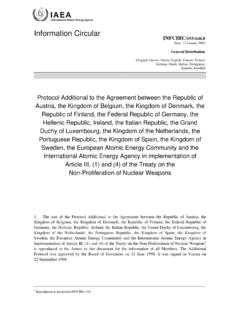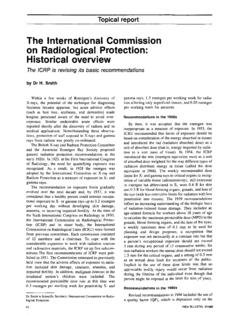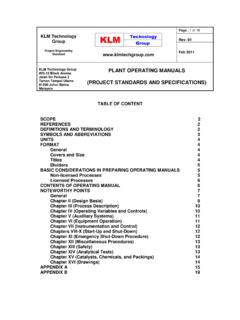Transcription of Nuclear power plant ageing and life extension: Safety aspects
1 Nuclear power & Safety Nuclear power plant ageing and life extension: Safety aspects An overview of issues and the IAEA's symposium by Stanislav Novak and Milan Podest Experience with large fossil-fired electrical generat- structure because of one or more of these factors. From ing units, as well as in all process industries, shows that this perspective, it is clear that this is a complex process plants begin to deteriorate with age after approximately that begins as soon as a component or structure is 10 years of operation. Similar phenomena will prevail produced and continues throughout its service life.
2 For Nuclear plants , and it is reasonable to postulate that their availability will be affected, as will their Safety , if appropriate measures are not taken. Age distribution of Nuclear power plants It is evident that the average age of power reactors in the IAEA's Member States is increasing. (See accom- panying graphs.) By 2000, more than 50 Nuclear plants will have been providing electricity for 25 years or longer. Most Nuclear power plants have operating life- times of between 20 and 40 years. ageing is defined as a continuing time-dependent degradation of material due to service conditions, including normal operation and transient conditions.
3 It is common experience that over long periods of time, there is a gradual change in the properties of materials. These changes can affect the capability of engineered compo- nents, systems, or structures to perform their required function. Not all changes are deleterious, but it is com- monly observed that ageing processes normally involve a gradual reduction in performance capability. All materials in a Nuclear power plant can suffer from ageing and can partially or totally lose their designed function. ageing is not only of concern for active com- ponents (for which the probability of malfunction increases with time) but also for passive ones, since the 0 5 10 15 20 25 30 35.
4 Safety margin is being reduced towards the lowest allow- Years of operation able level. Projected numbers of Nuclear power reactors reaching 30 years of operation 1990-2000. Effects of plant ageing 70. I. The main ageing effects of concern are changes in 60. physical properties ( , electric conductivity); irradia- I i I1. 50.. tion embrittlement; thermal embrittlement; creep;. I 40. fatigue; corrosion (including erosion and cracking O. assisted by corrosion); wear ( , fretting and cracking | 30. 1I I. z assisted by wear, such as fretting fatigue).
5 20. The term " ageing " thus represents the cumulative changes over time that may occur within a component or 10. 1990 91 92 93 94 95 96 97 98 99 2000. Year Messrs. Novak and Podest are staff members in the Department of -{Source: IAEA power Reactor Information System.). Nuclear power and Safety . IAEA BULLETIN, 4/1987 31. Nuclear power & Safety ageing is certainly a significant factor in determining led to an increased effort in the review and development the limits of Nuclear plant lifetime or life extensions. No of monitoring, testing, and inspection methods to ensure Nuclear plant , including those still under construction or timely detection of ageing degradation.}
6 Being mothballed, should be considered immune from its Coping with the ageing process of Nuclear power effects. plants requires a systematic approach in analysing these The rate of ageing depends strongly on both the phenomena. Experimental and theoretical methods service conditions and the material sensitivity to those should be developed to evaluate its impact on plant conditions. Therefore, consideration about ageing must performance. Effective methods of inspection, surveil- start in the design phase by selecting adequate materials lance, and monitoring should be implemented during and it should be continued throughout its complete life operation to evaluate the "qualified life" of the compo- cycle.
7 Nents, systems, and structures. This should be the basis Although Nuclear plant ageing could have an impact for their timely and effective maintenance, repair, and on the efficiency of electric power generation, Safety replacement, with particular attention to systems and could be affected as well if degradation of key compo- components important to Safety . nents or structures is not detected before loss of func- tional capability, and if timely corrective action is not International symposium taken. What must be understood is how the ageing Just as the proper management of plant ageing is process may change the likelihood of component failures drawing increasing interest, so are the economic aspects of extending the lifetimes of Nuclear power plants .
8 The (and therefore reduce Safety margins), and how age IAEA gives attention to both topics in its programmes. degradation can cause such events to be initiated. Recently, the Agency organized the International Concerns about ageing of equipment stem from the Symposium on Safety aspects of ageing and Main- fact that failure can occur simultaneously (or effectively tenance of Nuclear power plants , which was held in so) in redundant Safety systems. Redundancy (coupled Vienna, from 29 June to 3 July 1987.* It was the first with diversity) is the principal means of guarding against one organized by the IAEA on this subject and it was the consequences of random failures of equipment and therefore directed at a broad spectrum of participants.
9 Providing assurance that at least one complete chain of technical and managerial staff engaged in Nuclear power Safety systems is functional at all times during plant plant operation, regulatory body staff, consulting and operation. The required protection would not be architect-engineering organizations, vendor technical provided if equipment ageing degrades the functional and management staff, and Nuclear power plant technical capability to the point where the increase in stress levels and managerial staff involved in maintenance activities.
10 Associated with a design basis event could cause simul- It was attended by 140 participants from 30 countries taneous failure of redundant systems (or their failure and three international organizations. Important topics within a critical interval of time). addressed at the symposium are highlighted in the fol- lowing paragraphs. Monitoring and detection National efforts Operating organizations have been using different programmes or methods to prevent, detect, correct, and In some countries, several programmes have been mitigate failures of systems and components from any started that encompass studies aimed at achieving an cause including the effects of ageing degradation.











